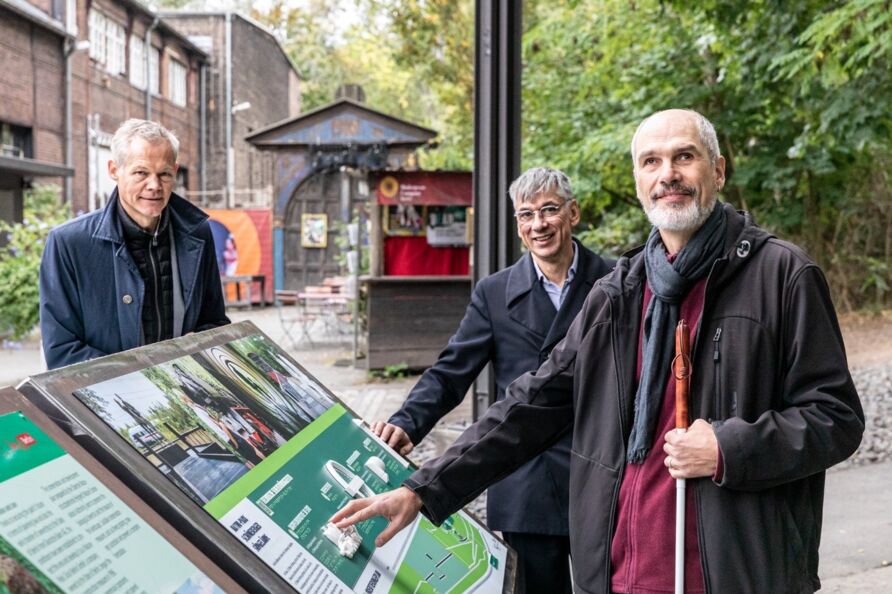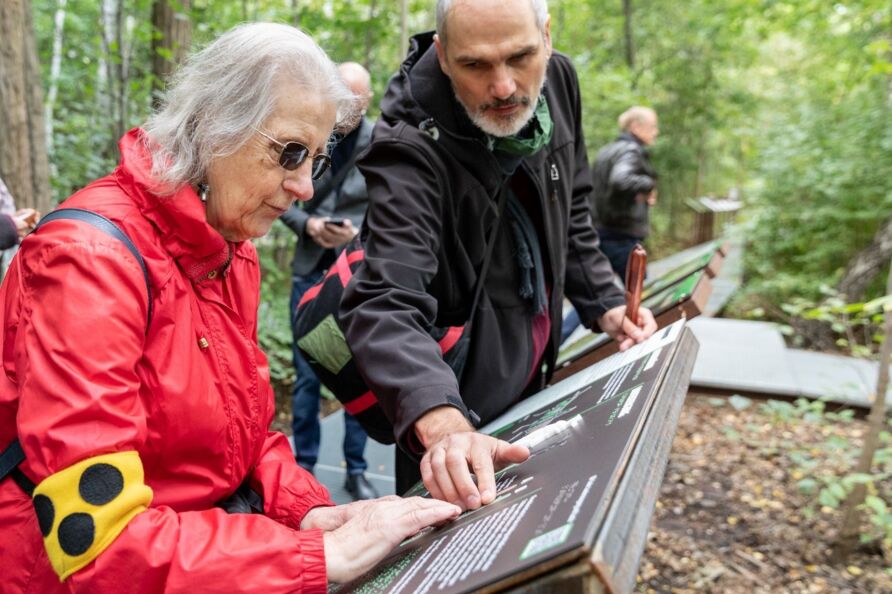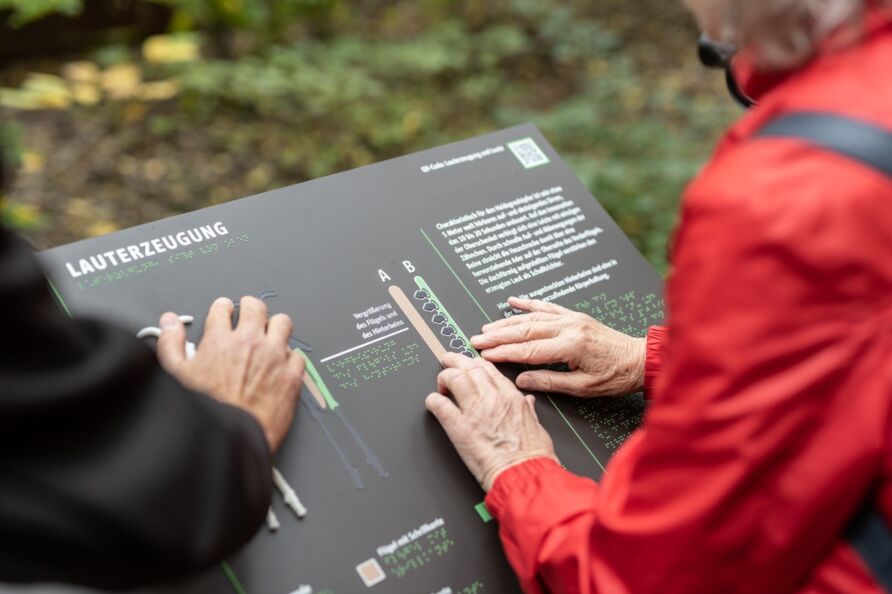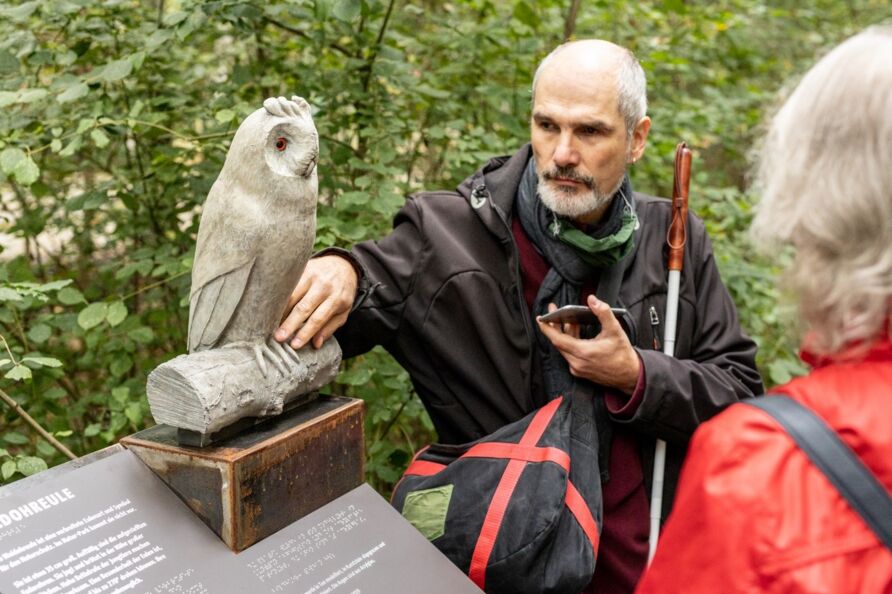Ground-Breaking Nature (Bahnbrechende Natur)
Collaborative project of the German Federation of the Blind and Partially Sighted (DBSV) and the Department of Nature and Urban Development Berlin

The „Ground-Breaking Nature“ project worked on the accesibility of the open air exhibition in the nature park „Schöneberger Südgelände“ in Berlin. This park was formed by an area of railway, used by the railway company of eastern Germany that was cut by the division of Germany after the second world war and was situated in western Berlin. Over 40 years the area was reclaimed by nature and created an unique nature reservation on the railway tracks.
The exhibition Ground-Breaking Nature explains the development of the area and the natural mechanisms that work in a place where plants and animals can develop undisturbed.
The exhibition was enhanced in a collaborative process with audio descriptions of the exhibition tables, with tactile inclusive tables and with orientation help for an independent visit of the area by blind and partially sighted people.
Three general dimensions of accessibility:
4. Information and Orientation
- description of the directions from the next metro station to the exhibition on a website
- file with GPS-data to import to a navigation app to guide people to the exhibition and to more interesting places in the nature park
- tactile floor guidance elements that work in an open air nature place according to the metal art conception installed in the park, these elements help blind people to find the exhibition using the directions
- accessible website with all informations to the exhibition
- by these measures the project is the first approach to allow blind people an independent navigation in an art museum

5. Audio Information on the Exhibition Tables
- the exhibition tables were represented on an accessible website in their original design; all texts are readable with screenreaders and all images and photos are described in detail
- all texts and audio descriptions are also available in audio format and read by professional speakers; the audio files can be streamed or downloaded on the website or acessed directly from the exhibition tables via QR codes

6. Additional tactile inclusive exhibition tables
- the additional elements show things that are presented only visually so far; so they have an added value for all visitors; they show the life cycle of wild bees, the sound creation of grasshoppers, different trees, the shape of their leaves, pieces of their trunks etc.
- in the creation guidelines for good tactile images were used
- the reliefs are designed as close as possible to the original
- the reliefs are optimized for open air use and are very durable
- the characteristic of tactile exploring by blind people were followed like avoiding perspective, too big or too small sizes, as realistic in 3D as possible

Process
- the department of nature Berlin initiated the project and was strongly interested in a collaborative process between the administration of Berlin and visually impaired persons
- blind and partially sighted people were involved in planning, steering and running the project in all stages
- as project partner DBSV ensured the further use of all experiences made in the project
Results und Documentation
- the exhibition is present on the website that shows a very innovative and strongly inclusive way of access to nature:
www.berlin.de/sen/uvk/natur-und-gruen/naturschutz/ausstellungen/bahnbrechende-natur/ - additional information on orientation on the DBSV website:
www.dbsv.org/naturparkberlin.html - in the project also recommendation for guided nature tours with visual impaired guests were created:
www.dbsv.org/naturfuehrungen.html
Impact and Follow-Up
- the project was presented in September 2020; unfortunately because of the corona lock-downs and measurements of social distancing not so many blind and partially sighted people could access the exhibition so far; but the interest in the exhibition is quite strong
- several nature park managements looked at the project and discussed with the organisers to learn from it in making own accessible exhibition projects
- DBSV is constantly in contact with nature park managements who want to offer accessible exhibitions like in the project „Nature without Barriers“
https://www.nature-without-barriers.eu/de/startseite.html





